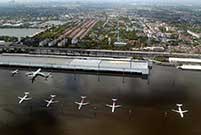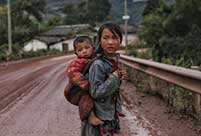

EIJING, Dec. 22 -- China has detailed its urban planning vision, which has been designed to make its sprawling cities more inclusive, safer and better places to live.
In a statement released after the Central Urban Work Conference, which ran from Dec. 20 to Dec. 21 and was attended by President Xi Jinping and Premier Li Keqiang, policymakers pledged to transform urban development patterns and improve city management.
The last time China held such a high-level meeting was in 1978, when only 18 percent of the population lived in cities. By the end of 2011, in excess of 50 percent of the population called the city their home.
While the "triumph of the city," which characterized the past decades, has brought about significant social and economic changes in China, it has also spawned problems such as traffic jams, air and water pollution and a stretched public safety network.
On Tuesday, 40 cities in north China had issued alerts for air pollution. Beijing, together with the cities of Baoding, Handan, Langfang and Xingtai in the neighboring province of Hebei, had issued red alerts, the most serious level of the four-tier warning system.
Such urban ills have provoked the ire of the public, putting pressure on city planners to find workable solutions.
The Central Urban Work Conference said livable cities should be the central goal of China's urban planning, and urban development should be focused on creating environments where people can live in harmony with each other and nature.
The government will take a more sophisticated approach to its urban planning, and encourage enterprises and citizens to participate in creating the cities of the future, according to the statement.
SAFETY FIRST
Tuesday's statement said safety would be the top priority in city development and management.
"Safety should underpin every aspect of urban work," the statement said.
The emphasis comes in the wake of fatal accidents that have sent shockwaves through city planning departments all over the country.
A landslide hit an industrial park in Shenzhen on Sunday after a huge pile of construction waste collapsed and flowed down a hill, killing one and leaving 76 people missing.
On Aug. 12, two explosions ripped through a warehouse storing hazardous chemicals and residences nearby at Tianjin Port. The blast claimed 173 lives, including 104 firefighters.
Teng Wuxiao, director of Fudan University public safety research center, said there was a lack of systems in place to assess risks.
"In China, the government can deal with the aftermath very well, but more must be done to detect risks and prevent accidents," he noted.
INTEGRATING RURAL MIGRANTS
China's urbanization drive will integrate rural residents into cities by granting migrant workers household registration, as long as they have lived and worked steadily there for a set period of time, said Tuesday's statement.
While nearly 55 percent of the population live in cities, less than 40 percent are registered urban residents. Many migrant workers are denied "hukou" (official residence status), which means they are not entitled to equal education, employment rights and social security services.
China plans to raise the number of registered urban residents to around 45 percent by 2020.
CITY PLANNING
The size of a city shall not exceed the available resources and environment, Tuesday's statement said.
Currently, Beijing, Shanghai and Chongqing municipalities all have populations exceeding 20 million. Cities like Tianjin, Guangzhou and Shenzhen each have more than 10 million.
The statement said China will control city development in a bid to address aimless expansion.
More will be done to upgrade city clusters in the eastern region, such as encouraging migration to central and western regions, according to the statement.
China will also "largely complete" the ongoing renovation of urban substandard housing, underdeveloped areas in cities, and dilapidated housing by 2020.
 Are these the world’s scariest landing strips?
Are these the world’s scariest landing strips? In pics: Left behind children in China
In pics: Left behind children in China Eight modern day engineering marvels of China
Eight modern day engineering marvels of China Chinese beauty with sexiest bottom
Chinese beauty with sexiest bottom Charming female bodybuilders of Chengdu University
Charming female bodybuilders of Chengdu University Polish sports stars strip off for risqué calendar
Polish sports stars strip off for risqué calendar Spectacular aerial photos of the Three Gorges
Spectacular aerial photos of the Three Gorges Contestants of Mrs. Globe pose for photo in Shenzhen
Contestants of Mrs. Globe pose for photo in Shenzhen
 Bikini models attend hot pot banquet in Hefei
Bikini models attend hot pot banquet in Hefei Top 20 hottest women in the world in 2014
Top 20 hottest women in the world in 2014 Top 10 hardest languages to learn
Top 10 hardest languages to learn 10 Chinese female stars with most beautiful faces
10 Chinese female stars with most beautiful faces China’s Top 10 Unique Bridges, Highways and Roads
China’s Top 10 Unique Bridges, Highways and RoadsDay|Week